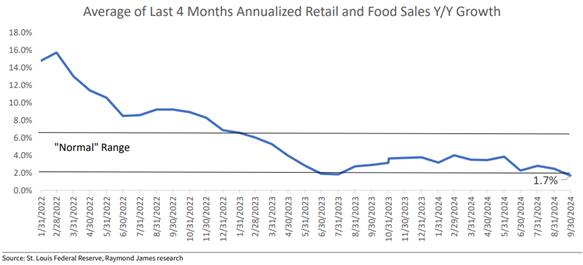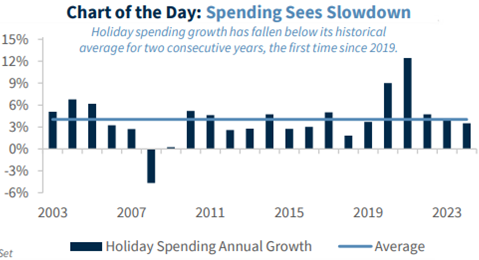Wentz Weekly Insights
Retail Sales Strong, Earnings in the Spotlight
US stocks saw another week of gains with the three major indices finishing higher for the sixth consecutive week and S&P 500 closing at a new all-time high. It was a week that saw interest rate sensitive sectors perform the best, like utilities, real estate, and financials. In fact, utilities are the years best performers so far, up 29% YTD which even outpaces the technology sector’s 19.9% gain. The S&P 500 closed at a new high on Friday while the index, along with the Dow and Nasdaq, has increased for the sixth consecutive week.
There was less macro headlines to digest last week, with most focus on individual company earnings reports. A couple headlines came from technology companies including ASML and Taiwan Semiconductor (TSM). ASML, who makes extreme ultraviolet (EUV) lithography machines that are critical for making advanced chips, accidentally posted its Q3 financials on its website that indicated strong demand for its AI related products, but all other parts of its business that were slow and is expected to be the case in 2025. Its forward guidance was well below analysts’ consensus estimates. Worries increased after the report about non-AI related demand trends.
The sentiment in the semi sector improved after Taiwan Semiconductor, the manufacturer of semiconductors including advanced chips that power artificial intelligence, gave numbers that blew away expectations with its forecast even better. It guided for revenue growth of 30%, well ahead of the consensus estimate of 22%. Shares rose 10% as a result.
Finally, Netflix reported its results Thursday after the close that sent its shares up 11% Friday. The reason was better revenue growth and it said it gained 5.07 million subscribers to a total of 282.72 million global paid memberships. Its ad-supported subscriptions accounted for 50% of new memberships, growing 30%, and the company saying it is becoming more profitable than expected.
Earnings projections for Q3 are near +3.4%, which is lower than the 4.3% expected three weeks ago when the quarter started, but still 85% of the S&P 500 has yet to report results.
There was not much economic data to digest, but the release of September retail sales caught attention Thursday morning. Sales grew a better than expected 0.4% in the month despite a 1.6% decline in energy prices. Taking out the two volatile categories of energy and vehicle sales, retail sales increased a strong 0.7%. However, there has been talks of seasonal adjustments resulting in stronger data than it appears. As Raymond James notes, unadjusted year-over-year figures provide a better/more accurate picture where retail sales are weaker than the headline suggests. Year-over-year sales are up just 1.7%, not even enough to keep up with inflation. As the chart below shows, retail sales have been weaker since May and at the low end of the “normal range” since the beginning of 2023.
This week becomes busier with 20% of S&P 500 companies reporting Q3 financial results before the busiest week of the quarter next week. The economic calendar is light on data releases while Fedspeak will be lighter than recent weeks.
Week in Review:
Big tech drove gains at the S&P 500 index level but sector wise, it was a week of outperformance for utilities, real estate, financials, and materials, while energy and health care underperformed. The major indexes finished as follows: Russell 2000 +1.87%, Dow +0.96%, S&P 500 +0.85%, and Nasdaq +0.80%. Treasuries were relatively unchanged as yields did not move much over the week. The 2-year Treasury yield was unchanged at 3.97% while the 10-year yield fell 3 basis points to 4.08%. The dollar was stronger across most currencies with the index up 0.6%, gold rose 2.0% for another new all-time high, while Bitcoin rose 9.6%. Oil saw another weekly decline after seeing lower oil demand forecasts from OPEC and easing Middle East tensions after Iran confirmed it would not target Iran’s oil facilities, falling 9.1% on the week for the worst week in 19 months.
Recent Economic Data
- Retail Sales: Monthly retail sales rose a better than expected 0.4% in September despite what was a 1.6% decline in gasoline sales due to lower prices. Excluding gas and vehicle sales (which were flat in the month) retail sales increased a pretty solid 0.7%, which is well above the expectation for a 0.3% increase. Of the 13 major categories, 10 of them saw an increase in sales in the month. Strength was led by miscellaneous stores up 4.0%, apparel up 1.5%, health/personal care up 1.1%, grocery stores up 1.0%, and restaurants/bars up 1.0%. Declines were seen in furniture and electronics. Over the past 12 months, retail sales have increased just 1.7%, and after accounting for inflation of 2.4%, real retail sales are actually down 0.7% over the past year. In addition, excluding vehicle and gas sales, retail sales are up 3.7%, 1.3% in real terms (inflation adjusted).
- Housing Starts: The number of housing starts in the US fell less than 1% in September to a seasonally adjusted annualized rate of 1.354 million homes. The pace of housing starts is down 1% from a year ago. The number of permits to build a new home was at an annualized rate of 1.428 million, down 2.9% from August and down 5.7% from a year ago. However, the number of housing units under construction has been on a steady decline, now down 12% from a year ago after a 2% decline in September.
- Housing Market Index: The housing market index, an index on homebuilder sentiment, was 43 in October, a small improvement from 41 in September. The index on present sales rose from 45 to 47, the index on projected sales over the next six months rose 4 points to 57 for the highest since April, while the index on traffic of prospective buyers rose 2 points to 29. These index readings indicate an improved picture for homebuilders, but activity and sentiment still remains very low.
- Empire State Manufacturing Index: After a month of moving into positive territory, the Empire State Manufacturing index moved back into negative, suggesting manufacturing activity remained weak in October. The index was -11.9 for October, down from 11.5 in September. The report noted weakness in new orders, shipments and shorter delivery times, along with improved labor conditions, but the pace of input and selling price increases picked up.
- Philly Fed Manufacturing Index: The Philly Fed manufacturing index was 10.3 for October, rising from around the breakeven level in September and above expectations indicating decent growth in manufacturing activity in the month, opposite of what was reported in the New York region from the Empire State index earlier this week. The report noted most activity indicators improved and turned positive in October, but employment remained weak while prices continue to rise.
- Industrial Production: Industrial production declined 0.3% in September, slightly more than the 0.1% decline expected and comes after a 0.8% increase in August was revised down to a 0.3% increase. The decline in production in September was due mostly to a 0.5% decline in manufacturing, a 2.2% decline in mining, and offset somewhat by a 0.6% increase in utilities. The decline was likely a result of a major strike at Boeing, and effects of the two hurricanes, offset by strong growth in high tech equipment (due to AI related demand).
- Jobless Claims: The number of unemployment claims filed the week ended October 12 was 241,000, a decline of 19k from the prior week which saw the highest claims in 13 months, but most attributed that to the recent hurricanes and strike by Boeing workers. In addition, last week’s claims of 260,000 was unrevised. The four-week average of new claims was 236,250, up about 5k. The number of continuing claims was 1.867 million, up 9k from the prior week, with the four-week average up 11k to 1.843 million.
Company News
- Boeing Job Cuts & Capital Raise: As it deals with a worker strike, mounting debt, and credit uncertainty, Boeing announced plans to cut 17,000 jobs (which are unrelated to the current strike), equal to about 10% of its workforce in effort to reduce operating costs. It later said it has agreed to a $10 billion credit deal that cushions its balance sheet as well as filing for a mixed-shelf offering up to $25 billion, which is a preliminary step before raising equity, to further improve its financials.
- More AI Chip Export Restrictions: A Bloomberg report said US government officials are in talks to cap the sales of advanced AI chips from Nvidia and other chipmakers on a country-specific basis in a move to curb some country’s AI capabilities. The report said the focus is on Persian Gulf countries who have ample funds for these investments and are growing demand for AI data centers significantly.
- Volatility in ASML: Semiconductor stocks, particularly equipment makers and services providers like ASML and Lam Research, were under pressure last week in part to the news above about the US government possible export restrictions, as well as earnings figures from ASML that were mistakenly pre-released to the markets early that showed its bookings in the quarter fell short of expectations (while sales were better than expected). The miss was pretty severe – bookings of 2.63 billion euro was half the analyst estimate of around 5.3 million euro. The company also provided sales guidance for 2025 sales below consensus.
- Qualcomm & Intel: A WSJ report back on September 20 said Qualcomm approached Intel about a possible acquisition, a deal that was “far from certain” and what would likely create a lot of antitrust concerns. To satisfy regulators, the report said Qualcomm could sell assets or parts of Intel to other buyers. A report yesterday said Qualcomm will wait until after the election, and possibly after the inauguration, before making its final decision. Also, Intel stock fell more after reports its products are under a security review in China.
- Walgreens Closing Stores: Walgreens reported its quarterly financial results and with its earnings release announced it would launch a three year cost cutting plan that would save $ 1billion as the chain deals with challenging macro issues like slower consumer spending at its stores and lower drug reimbursement rates from pharmacy benefit managers. The plan includes closing 1,200 stores and pharmacies out of the 8,000 that currently stand.
- Taiwan Semiconductor’s Strong Quarter: Semiconductor stocks saw a strong end to the week after the world’s largest chip manufacturer Taiwan Semiconductor released a very strong quarterly earnings report that sent its shares up 10% on Thursday. Its revenue and earnings were above the markets’ estimates and it gave a Q4 forecast that was well above estimates (revenue of $26.5 billion vs $24.9 billion expected which equals growth of 30% y/y). The strong growth was obviously driven by demand for AI related chips, but also cost controls/efficiencies, while non-AI demand brought up some concerns but management said it is stabilizing and starting to improve. According to FactSet, the read-through was a positive for AI-related chips, systems, servers, and networking. Expectations of healthy PC and smartphone demand also likely positive for handsets, PC names.
- Uber & Expedia: The Financial Times came released a report that Uber is considering an offer for Expedia to expand its offerings. The report adds very early stages and no discussions have occurred. CNBC later reported there were no ongoing discussions between the two.
Other News:
- Oil Demand Forecasts Fall: Crude oil took a move lower to begin last week, dropping 5% after OPEC downgraded its global demand forecast for the third consecutive month along with data showing China’s oil imports fell for the fifth consecutive month in September. OPEC said it expects global oil demand to grow 1.93 million barrels per day in 2024 and 1.64M bbl/day in 2025, down from 2.03M bbl/day and 1.74M bbl/day, respectively, almost all due to lower demand from China. Total demand is estimated to be 104.1 million bbl/day in 2024.
- “Click to Cancel” Rule: The FTC (Federal Trade Commission) adopted a final rule called the “click to cancel” rule that would require businesses to make it as easy to cancel a subscription as it is to sign up. The FTC said the rule was created after receiving an increasing number of complaints on how difficult it was to cancel a subscription. It would require them to get consumer’s consent for subscriptions, auto renewals, and free trials that convert to paid memberships, all of which must follow the same “as easy to sign up” cancellation rules.
- Recent Fed speak:
- Minneapolis Fed President Neel Kashkari made several comments last Monday regarding the “neutral rate” saying the Fed’s ability to raise rates aggressively and the to highest in 20 years without bringing a recession indicates the neutral rate had increased during the pandemic. He added that as the US debt continues to increase, the neutral rate will rise.
- Fed Governor Waller discussed three paths for interest rates; a gradual decline, sharper cuts, or a pause, each of which would be determined on the data, but all that ultimately get to the same place. He said the less likely case is inflation falls below its target and the labor market deteriorates, and the other route is inflation reaccelerates where the Fed would pause rate cuts. Overall he noted the Fed should take more caution on the pace of rate cuts than what they did in the September meeting (0.50% cut) due to the economic data and assuming the balance of risks between inflation and employment are better balanced. He noted a “disappointing” inflation report from last week, and the economy that is not decelerating as much as hoped.
- ECB Decision: The European Central Bank cut interest rates for the third time this year, cutting by 25 basis points to 3.75%, citing inflation that has dropped below its 2% target.
Did You Know…?
Holiday Shopping Spending Forecast:
We are entering the holiday shopping period and many strategists and retail organizations have come out with their estimates for holiday shopping for 2024. The National Retail Federation released its 2024 holiday shopping forecast which predicts that sales will grow at the slowest pace since 2018. The forecast is consistent with others, where the NRF expects consumer spending to reach $985 billion over the holiday shopping period, which would be a 3% increase from last year. It also said seasonal hiring is expected to grow at a slower rate with businesses expected to add between 400-500k seasonal workers, down from 509k last year. Deloitte said it expects holiday sales to rise between 2.3% and 3.3%. while Mastercard expects sales to rise 3.1%. The holiday shopping period is crucial as it accounts for roughly half of retailers annual sales. The chart below shows the growth in consumer spending over the past 20 years, with the blue horizontal line the average.
WFG News
Your Money, Your Vote
Join us as we discuss the 2024 Election and take a deeper dive into each of the Presidential Candidates’ campaigns. We will have a specific focus on the economy. All information provided will be obtained directly from each candidates’ platforms.
Please RSVP as soon as possible as seats will fill quickly!
We have three sessions to choose from:
Hudson Office – October 22 @ 6:00pm
Hudson Office – October 29 @ 12:00pm
Ravenna Office (Basement Hall) – October 30 @ 12:00pm
The Week Ahead
The focus the next two weeks will center around companies third quarter earnings reports with nearly half of the S&P 500 reporting over that period. This week we will see around 100 companies in the index report their quarterly figures. Notable names include 3M, GE Aerospace, Verizon, GM, Philip Morris, Texas Instruments on Tuesday, Boeing, AT&T, Coca-Cola, Tesla, Lam Research, IBM on Wednesday, UPS, American Airlines, Carrier, Honeywell, Union Pacific, on Thursday, and Colgate-Palmolive and Newell on Friday. It is a lighter week of economic data but still key reports on the housing market including existing home sales and new home sales. Elsewhere we will see an update on money supply, weekly jobless claims, durable goods orders, and consumer sentiment. In addition, the Federal Reserve’s Beige Book is released on Wednesday, which will provide us with anecdotal evidence on economic conditions throughout the 12 Federal Reserve’s districts.





